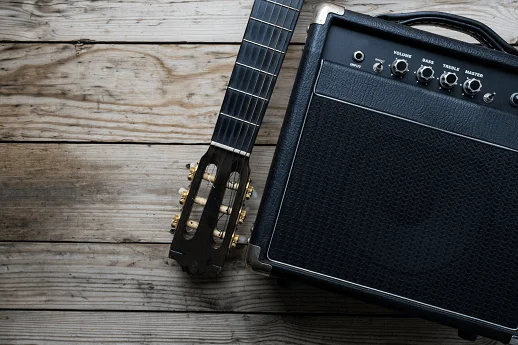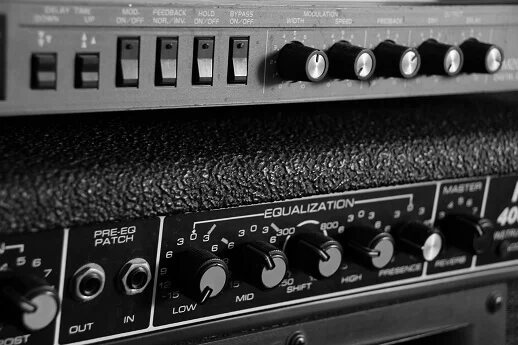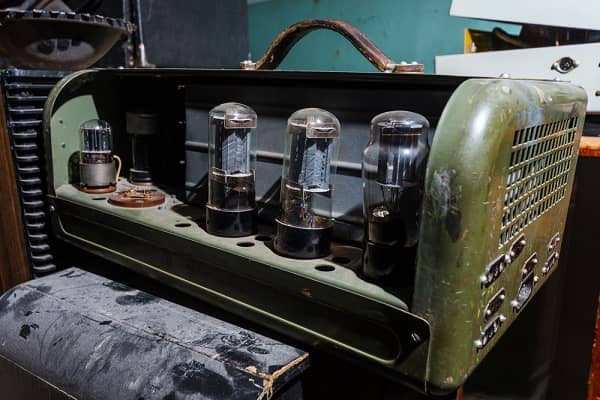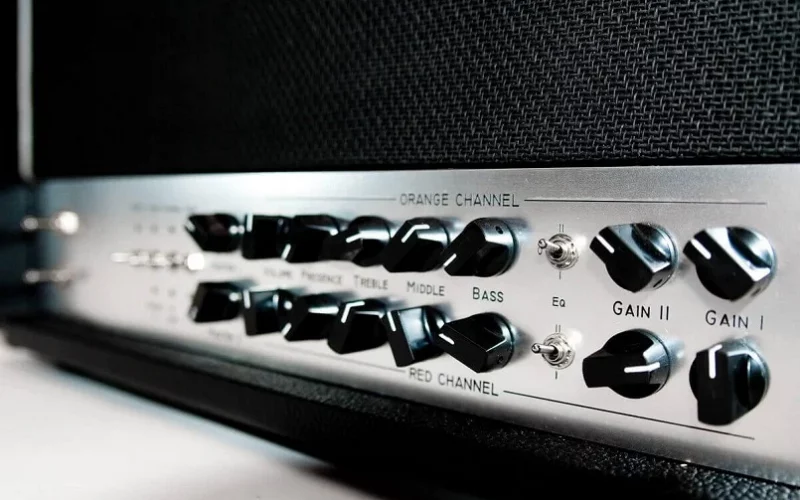Having played acoustic guitar for over a decade, I understand the excitement of getting a new axe and wanting to plug in right away. However, finding the best acoustic amp to match your tone can be tricky with so many options like Fender, Blackstar, or AER Compact out there.
As an experienced guitarist who has tested countless acoustic amplifiers over the years, I assure you that the recommendations in this article result from thorough evaluation to determine which acoustic amps consistently provide the best tone, volume, and durability to meet acoustic players’ needs.
Readers should continue reading this article because it compares top acoustic amplifiers’ key features in detail so acoustic guitarists can make an informed decision about investing in an amp that effectively projects their acoustic tone and style.
List of 7 Best Acoustic Guitar Amp
- Boss Acoustic Singer Live – Best Overall Choice
- AER Compact 60 MkIV – Best for Professional Use
- Fishman Loudbox Mini Charge – Best for Buskers
- Blackstar Sonnet 120 – Best for Sound Customization & Live Performance
- Yamaha THR5A Acoustic Modeling Amp – Best for Home Practice
- Fender Acoustasonic 40 – Best for Beginners
- Roland AC-33 Acoustic Chorus – Reliable Quality
Quick Recommendations: My Top Choice
After diving into the world of acoustic amps, my top picks are the Boss Acoustic Singer Live and the Fishman Loudbox Mini Charge.
The Boss Acoustic Singer Live has been my go-to for its incredible versatility. From home practice to live gigs, it’s a powerhouse with built-in effects catering to both beginners and seasoned players.
On the other hand, the Fishman Loudbox Mini Charge is a game-changer in terms of portability and convenience. As someone who enjoys playing outdoors, its battery-powered operation is a blessing. The sound quality is impressive, and its user-friendly design makes it a perfect choice for various playing environments.
These two amps strike the right balance, offering quality, versatility, and convenience for any guitarist.
Review Of Best Acoustic Guitar Amplifier
When searching for the best acoustic guitar amps available today to project your acoustic guitar’s natural tone, there are many options to consider.
In this review, I evaluate seven top acoustic guitar amplifiers on the market across key factors like sound quality, portability, features, and value to help players discover the right amp for their acoustic setup and performance needs.
1. Boss Acoustic Singer Live Amp: Best for Solo Performers
- Professional acoustic amplifier with premium sound
- Automatically creates accurate vocal harmonies
- Chorus effect on guitar channel
- Delay/echo effect on mic channel
Specifications:
- Output: 60 Watts
- Channels: 2
- Speaker: 6.5” woofer, 1” dome tweeter
- Effects: Harmony, delay/echo, chorus, reverb, built-in looper
- Weight: 10.5 kg/23 lbs
- Power Source: AC outlet
- Stand-Out Feature: Automatic vocal harmonies
As an experienced guitarist and singer, I highly recommend the Boss Acoustic Singer Live as the best all-in-one acoustic amp for solo performers on a budget.
This versatile 60-watt 2-channel amp delivers Boss’s renowned clear sound shaping to faithfully amplify both guitar and vocals. The real standout is the automatic vocal harmonizer which creates lush backup vocals to make a single vocalist sound like a chorus. The onboard looper also helps build layered arrangements.
Weighing just 23 pounds, the Acoustic Singer Live strikes an ideal balance of portable and powerful for buskers and coffee shop performers.
While costing under $600, it doesn’t feel cheap and includes premium effects and outputs so it can grow along with aspiring musicians. For maximum flexibility in a grab-and-go gigging package, it’s hard to beat.
Pros:
- Automatic vocal harmonizer
- Premium effects and I/O
- Great value
Cons:
- No Bluetooth connectivity
2. AER Compact 60 MKIV Combo Amp: High-End Option
- Professional, compact and powerful amp system
- Twin-channel acoustic guitar amplifier
- Dynamic controlled 60 watts power amplifier
- Outstanding AER tone in nearly all possible situations
Specifications:
- Output: 60 Watts
- Channels: 2
- Speaker: 1x 8” twin-cone
- Effects: Short and long reverb, chorus, delay
- Weight: 7.1 kg/15.6 lbs
- Power Source: AC outlet
- Stand-Out Feature: Exceptional acoustic tone
The AER Compact 60 MkIV is my top choice for an acoustic amp to handle serious gigging. As a veteran acoustic guitarist, I can attest this German-made amp delivers pristine, studio-quality amplification perfect for nuanced fingerstyle playing.
Weighing just 15 pounds, the Compact 60 strikes an ideal balance of portable size with powerful 60-watt output to fill small venues. The intuitive controls and built-in effects like rich reverb and delay allow for tone shaping without pedals.
While costing over $1,000, the superb construction, flexibility, and transparent sound make this an excellent investment for pro players needing reliable, inspiring amplification.
If you seek no-compromise acoustic amplification with exceptional reliability and tone, the AER Compact 60 MkIV is hard to beat.
Pros:
- Exceptional sound quality
- Sleek and compact design
- Gig-ready volume and intuitive controls
Cons:
- High price tag
3. Fishman Loudbox Mini Charge: Best for Buskers
- 2-channel Acoustic Guitar/Vocal Amplifier with Built-in Effects Feedback Suppression
- 60W
Specifications:
- Output: 60 Watts
- Channels: 2
- Speaker: 1 x 6.5″ woofer, 1 x 1″ tweeter
- Effects: Chorus, reverb
- Weight: 9.6 kg/21.2 lbs
- Power Source: Rechargeable battery (up to 18 hours on low volume)
- Stand-Out Feature: Bluetooth 4.0 connectivity
As an experienced acoustic guitarist, I highly recommend the Fishman Loudbox Mini Charge, especially for buskers and street performers needing portable amplification.
This lightweight, compact amp delivers premium Fishman tone and features like chorus, reverb, and Bluetooth to playback tracks, all powered by a built-in rechargeable battery for up to 12 hours (on average volume) per charge.
While it may lack some of the advanced tone-shaping of pricier models, the Loudbox Mini Charge provides exceptional plug-and-play simplicity ideal for solo acoustic guitarists and singers needing quality sound and reliability without cables.
For under $600, it’s a versatile portable PA solution that delivers quality acoustic amplification, wireless connectivity for backing tracks, and extended battery life to empower musicians wherever their performances take them.
Pros:
- Battery-powered and Bluetooth enabled
- Quality Fishman preamps
- Lightweight and durable
Cons:
- Limited effects controls
- Single DI output
4. Blackstar Sonnet 120 Combo Amp – Best for Live Performance
- Demo Sonnet 120 120W Acoustic Amp - Blonde
Specifications:
- Output: 120 Watts
- Channels: 2
- Speaker: 1 x 8” + tweeter
- Effects: Four reverb types (Hall, Studio, Chamber, Plate)
- Weight: 11.5 kg/25.35 lbs
- Power Source: AC power
- Stand-Out Feature: Full frequency response
The Blackstar Sonnet 120 is one of the most versatile acoustic guitar amps available, best suited for gigging musicians who need top-notch sound and maximum functionality.
With two independent channels, each equipped with 3-band EQ and reverb adjustment, you can customize your guitar and microphone tones. The clean, transparent sound projects nicely thanks to the 120 watts of power flowing through the efficient speaker configuration.
I especially appreciate the built-in Bluetooth connectivity, allowing me to play along perfectly in sync to backing tracks streamed from my phone. The anti-feedback system also works incredibly well to prevent noise issues.
One thing I dislike about Sonnet is that reaching for the controls isn’t as easy as with some other models on this list. It looks cleaner from the front though thanks to the control panel’s location, which may matter to some musicians.
Overall, the Sonnet has excellent build quality with a durable design and packs a ton of features.
Pros:
- Great transparent sound
- Dual channels with EQ and effects
- Bluetooth pairing capability
- Anti-feedback system
Cons:
- Controls positioned toward the rear can be slightly hard to access
5. Yamaha THR5A Acoustic Modeling Combo Amp – Best for Home Practice
- The THR5A offers four acoustic mic simulations
- Studio-grade effects to create recording-studio tone
- Feature VCM processors for serious realism
- Extended Stereo Technology creates an incredibly wide, spacious sound
Specifications:
- Output: 10 Watts
- Channels: 1
- Speakers: 2 x 3.15” full range
- Effects: Reverb, delay, chorus, flanger, compressor
- Weight: 2.0 kg/4.4 lbs
- Power Source: 8 x AA batteries or AC adapter
- Stand-Out Feature: Virtual Circuitry Modeling effects
Best for portability and practice, the Yamaha THR5A acoustic combo amp packs an impressive amount of features into a compact, battery-powered unit.
Weighing just 4.4 pounds, it’s easy to take anywhere without sacrificing tone – the virtual modeling provides simulations of mics and amps for studio-quality sound.
The range of built-in effects like rich reverb and delay allow you to craft pro-level recordings at home or dial in creative tones for practice. While only 10 watts, the stereo speakers sound full and defined within their limits. I also appreciate the onboard tuner and USB connectivity for computer recording.
With a durable construction and sleek aesthetics, the THR5A proves you don’t need a large, heavy amp to get great tone from the acoustic guitar. It’s ideal for home use, studio recording, or busking when portability is key.
Pros:
- Extremely portable
- Excellent modeling and effects
- Quality sound for the size
Cons:
- Only 10 watts limits volume
- Single input
6. Fender Acoustasonic 40 Combo Amplifier – Best for Beginners
- Only Fender guitar amp to feature a whizzer cone
- Extra ambiance with the instrument channel's built-in reverb
- Convenient dual front-panel inputs
- Simple, flexible, grab and go solution
Specifications:
- Output: 40 Watts
- Channels: 2
- Speakers: 2 x 6.5″ Full-Range with Whizzer Cones
- Effects: Digital hall reverb
- Weight: 7.5 kg/16.5 lbs
- Power Source: AC power
- Stand-Out Feature: Dual channel flexibility
The Fender Acoustasonic 40 is the perfect amp for beginner guitarists looking to amplify their acoustic sound. Weighing only 16.5 pounds, this highly portable amp delivers a crisp, clean tone from its two 6.5-inch speakers while drawing power from an outlet.
It provides two channels, each with 1/4-inch and XLR inputs to plug in both your guitar and microphone, making it ideal for singer-songwriters. While it lacks advanced effects, the three-band EQ and digital hall reverb give you basic tone-shaping options to dial in your sound.
Priced at an affordable $199, the streamlined interface makes it easy for novices to get great acoustic amplification right out of the box. If you’re just starting out and need a grab-and-go amp for practice and small gigs, the Acoustasonic 40 is a beginner’s best buy.
Pros:
- Lightweight and portable
- Affordable price
- Easy to use
Cons:
- Lacks advanced effects
- Not battery powered
7. Roland AC-33 Acoustic Chorus Combo Amp
- Natural, stereo acoustic sound through twin speakers
- Dual-channel configuration
- Reverb, chorus, and ambience effects
- Runs on AC power or eight AA batteries
Specifications:
- Output: 30 Watts (20W when using battery)
- Channels: 2 (Guitar, Mic/Line)
- Speakers: 2 x 5″
- Effects: Reverb, chorus, ambience
- Weight: 4.7 kg/10.36 lbs
- Power Source: 8 AA batteries or AC adapter
- Stand-Out Feature: Phrase looper
The Roland AC-33 Acoustic Chorus Combo Amp is a reliable powerhouse in the world of acoustic guitar amps. Boasting a sleek rosewood-look cabinet, it not only complements your living space but also enhances your acoustic guitar’s aesthetic.
Equipped with two channels (Guitar and Mic/Line), each with independent volume, multi-band EQ, and chorus controls, the AC-33 offers true stereo sound. It’s a versatile companion for guitarists and vocalists alike. The onboard Phrase Looper allows for creative riff recording, looping, and jamming, providing an immersive musical experience.
Portability is a strong suit, weighing just 4.7 kg and offering the option of battery power, making it ideal for buskers or gigging players on the go.
The Roland AC-33 stands tall as a reliable, versatile, and aesthetically pleasing acoustic amp, perfect for a wide range of musical scenarios.
Pros:
- True stereo sound for an immersive experience
- Onboard Phrase Looper for creative expression
- Battery-powered amp for on-the-go musicians
Cons:
- Looper functionality is basic
- Some newer amps offer better output options
Difference Between an Acoustic Amp and a Regular Amp
The main difference between an acoustic and a regular electric guitar amp lies in how they process sound.
Typically, electric guitar amplifiers enhance the tonal spectrum of electric guitars. In contrast, good acoustic amps usually only amplify the sound without altering its natural tone too much.
Aside from that, electric amps usually have a stronger mid-range, while the best acoustic amplifiers typically feature tweeters for better high-end frequencies.
Additionally, acoustic guitar amps very often have a mic input for vocals, as well as to allow you to hook an acoustic guitar without piezo pickups to the amp. Electric amplifiers typically don’t have mic inputs.
With that said, many acoustic guitar amps today have onboard effects anyway, so they may also be used to enhance the sound of an acoustic guitar.
The boundaries between acoustic and electric amps these days are fairly blurred, and you may use any type of amp as long as it has the necessary inputs and satisfies your needs.
If you want to learn more about the differences between an acoustic amp and a regular electric amp, check the following post acoustic vs electric guitar amp.
What Guitar Amp Should a Beginner Choose?

Choosing the right amp is a bit difficult if you’re a beginner, there are so many models and you’re not sure which amplification system will suit you. There are a couple of things you should keep in mind before buying one.
Bigger Isn’t Better: The bigger the better? Nope, if you’re playing at home you won’t need anything bigger than a 100-watt amp.
Even 50 or less will do if you are not a professional. Amplifiers of 100 watts or more are for playing outdoor concerts and gigs. Also, keep in mind the portability issue.
Choose An Amp With Simple Controls: Using an amp can be complicated for beginners, so, choosing an amplifying system with simple controls can be helpful. Starting off with an amplifier that has one channel and some features like gain and reverb is a good choice.
How to Get the Best Out of Your Amp?
Acoustic guitar amps have different tones and each one of them is unique. But how do you get your amp to make that sweet and natural tone that you’ve always wanted to hear? Here are some tips on how to get the perfect acoustic tone.
Location of the amp
Put your amplifier against the wall and jam for a bit then, move it and put it on a table. As soon as you start playing, you’ll notice that the tone has changed! Moving your guitar amp will result in different tones.
So, if you don’t like your amp’s tone you can simply change its position. You can also look for an amplifier stand if you like the acoustic guitar tone of the amp when it’s raised off the floor.
Cables
The cables you’re using have a very big effect on the amp’s tone. Using low-quality cables will give you a weak and distorted tone.
Strings
So, your amp’s tone has become dim? Check your strings. Cleaning your strings regularly and changing them helps a lot with getting a better tone. So always make sure to change your strings every once in a while.
Also Read: Best Acoustic Guitar Strings for Beginners
Features You Should Look for in an Amp
Choosing the right amplifier depends on what you’re going to do with it, some amplifiers are fit for playing gigs, some are for just playing in the practice room and some are best suitable for a recording studio.
This is why deciding what you’re going to do with your new amp is essential before getting one.

Acoustic guitar amps differ in size, power, controls, effects, and number of channels. So to make things easier for you, we’ve made a list of features that you should look for in the best acoustic amp.
1. Power output
If you’re planning on getting an amplifier for gigs and live performances you should look for a 100-watt amp or more. Amplifiers of less than 100 watts are usually for home use and practice.
2. Channels
Most acoustic amps with 1 channel will make do. But acoustic guitar amps with 2 channels come in handy if you want to plug another guitar/instrument in.
You can also plug in a microphone so you can sing while you’re playing. Make sure that each channel has its own controls so you can adjust the volume, reverb, and tone of each channel.
3. Effects
Guitar amplifiers usually come with built-in guitar effects. But, not all of them have the same effects. Some have reverb effects while some have built-in chorus effects, some have both.
If you get an amp with many built-in effects, you won’t have to break the bank on effect pedals.
4. Inputs
Best acoustic guitar amps typically have various input interfaces – usually 1/4-inch connectors for the guitar itself and an XLR connection for microphones. If your acoustic guitar doesn’t have a piezo pickup, then a microphone input is a must.
For most people, these inputs are more than enough. Some guitar amplifiers also have 3.5mm ports that allow you to connect a laptop or smartphone to the amp.
Needless to say, your acoustic amplifier should have all the inputs you need.
5. Feedback control
Feedback adjustment is an important amenity because the pickup or microphone via which the signal is sent from the guitar to the amp may have feedback. Control on the unwanted response suppresses this phenomenon.
Simple forms of noise control have no adjustability, while more complex systems may allow you to treat specific frequencies. The latter drives amp costs up quite a bit.
Do You Need a Tube or Solid State Amp?

There’s a huge difference between tube and solid-state amps. Tube amps use vacuum tubes to increase the power of the guitar signal to the amp while solid-state amps use solid-state electronics like diodes and transistors. Tube amps can be a bit pricey and you have to change the tubes every once in a while.
Each one of those amps has its own tone. Tube amps have a warm tone and the overdrive is smooth while the distortion in solid-state amps can be a bit fizzy and harsh. Tube amps sound louder than solid-state, if you have both 20-watt solid and tube amps you’ll see that the 20-watt tube amp is louder.
Most of the acoustic amplifiers are combo hybrid amps. They’re a combination of both solid and tube amps. It uses both vacuum tubes and solid-state electronics.
Can You Play an Acoustic Through a Tube Amp?
Yes, you can play an acoustic guitar through a tube amp. And despite what some people may suggest, playing an acoustic through a tube amp doesn’t damage the amp. If your tube amp has the right inputs for your acoustic/acoustic-electric guitar, you will be able to use it to amplify the instrument.
With that said, tube amps aren’t the finest choice for acoustic guitars because they don’t deliver as natural sound as acoustic guitar amps. So unless you have no other options, don’t pair an acoustic guitar with a tube amp.
Another issue to consider is that tube amps don’t always have mic inputs. This will matter with acoustic guitars that don’t have piezo pickups.
Frequently Asked Questions
How do I choose an acoustic guitar amp?
When selecting an acoustic guitar amplifier, I focus first on the features I need for my playing style and budget. As a solo singer-songwriter doing coffeehouse gigs, I’m after crystal clear sound and enough power to fill a medium-sized venue.
My Fishman Loudbox Mini delivers the warm mic’d tone I want at a price I can afford. Consider your own amplification needs and research brands like Fishman, Yamaha, Fender, and Roland.
Ensure the wattage and speaker size match the spaces where you intend to use it. If possible, test models in person before deciding.
Do you need a special amp for acoustic guitars?
You don’t really need a special amp for acoustic guitars, although acoustic amps are distinct from other types of amps. As long as an amp has the right inputs, it will work with an acoustic guitar no matter what.
If your guitar doesn’t have a piezo pickup, then the amp should have a mic input so that you can mic up the guitar.
Can I play my electric guitar through an acoustic amp?
You may play an electric guitar through any amplifier, including an acoustic guitar amplification system. You will be able to hook an electric guitar to any amp as long as it has the right inputs.
However, the sound may be a bit dry because acoustic guitar amps don’t enhance the mid-range as standard electric guitar amps do. Unless you have a good reason, don’t pair an electric guitar with an acoustic amp – this doesn’t make much sense.
How can I make my acoustic guitar sound better with an amp?
The primary way of making an acoustic guitar sound better with an amp is by adjusting the EQ. Most acoustic amplifiers have an equalizer that you can play around with to squeeze the most out of your guitar.
Another thing you may do is to use effects like reverb and chorus to enhance the acoustic sound. Effects don’t work well in some compositions, and not everybody likes to distort the natural sound of their guitars, but this is a viable way of improving sound.
Keep in mind that “better” is subjective and depends entirely on your preferences and musical needs. Educate yourself as to what your amplifier can do and try to play around with its settings to see what works the best for you.
Related Articles:
- Best Guitar Amplifier Stand Review
- Best Acoustic Guitar Pickups Review
- Top Acoustic Electric Guitars In 2023
- How To Make An Acoustic Guitar Louder
About the Author
Gustavo is a music teacher and classical guitar player from Brazil, currently residing in Dublin, Ireland. He holds a graduate degree in Classical Guitar Performance from the Federal University of Pelotas. In 2020, Gustavo successfully completed a Master's degree in Sound Engineering from the Academy of Sound in Ireland.


